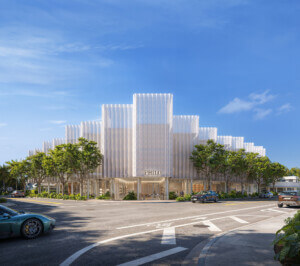Hao Ko, principal and design director at Gensler, will be delivering the keynote presentation at the 2017 Tech+ Expo (May 23, New York City).
Like a test rendering of a 3-D model, Gensler’s new headquarters for microchip maker NVIDIA in Santa Clara, California comes haltingly into view across the landscape, a glitchy image slowly gaining resolution.
The 550,000-square-foot structure has been in the works since before the Great Recession and after nearly a decade in development, work is quickly progressing on final construction. The structure is on track to open for business in September of 2017—construction photos provided to The Architect’s Newspaper (AN) by Hao Ko, principal and design director at Gensler, indicate that work on the building envelope is almost complete, with the installation of final interior finishes and the landscape underway.
Devcon Construction is building the project and Louie International is acting as the structural design engineer.
Along the exterior, practically every edge of the wide, triangular structure is canted subtly. A roof profile that appears curved is actually made up of broad, segmented lines. Along two sides, the building bulges at the middle, creating fat, cyclopean bay windows.
From above, the building is revealed across the landscape as a microchip-inspired paper airplane—a thin roof structure pierced with triangular skylights heaving over the earth. The building is actually capped by a steel truss roof supported by steel beam walls and columns. The deeply-overhanging and undulating roof creates a cavernous interior volume below. Whenever the roof’s folded planes meet at a peak or a valley, they turn downward as large steel section columns that resolve themselves dutifully and unceremoniously by plunging straight into the concrete slab.
[interstitia]
The construction images showcase a cavernous, two-level interior volume intersected by a series of opaque, faceted cores that interlock with one another and contain communal functions and meeting rooms. The peripheries of each floor plate are lined with work areas. Here, the formal rows of desks and more open-ended breakout spaces will exist in a broad, sky-lit space, framed by triangular roofing members above.
The project is notable for the collaborative effort between client and architect that allowed the design team to embed virtual reality-based (VR) visualization into the design process. NVIDIA worked to develop new uses for the graphics chip manufacturer’s Iray rendering engine: the project’s iterative daylight simulations involved modeling up to 5,000 light sources per image. Using the technology and cluster computing to pool GPU-power, designers were able to generate renderings in as little as ten minutes’ time, converting the technology into a rapidly-deployable design tool. The technology was also designed to include physically scanned materials in such a way as to capture light intensity and character—rather than to generate only various intensities of color, as is more common in rendering applications. The resulting “simulations” guided the design of the workspaces, where NVIDIA wanted to maximize quality of light. The scheme, as a result, ended up with fewer skylights than originally intended. Simulations showed that not as many skylights were needed to achieve the correct lighting effect designers were looking for.
Ko explained over telephone that virtual reality workflow integration allows for a project to take on more life, saying “previously we only had artists’ renditions of what a space could feel like.” Ko added that with VR, the architects at Gensler wanted to figure out how could get “more reality” into the design experience. Scott DeWoody, Gensler’s creative media manager, said that the use of virtual reality was integral to the NVIDIA project and that the firm had “found a use for it at every spot in the design process.” VR is something that is not only easy to adopt into the traditional office workflow, DeWoody explained, but once rendering times are reduced, the tool can result in better overall design quality, as designers “render everything around them, instead of just (rendering) an open scene.”
Ko agreed that the advanced simulation techniques add more to the design process than traditional renders, saying, “I’m old school—I came in the profession back in the day when we were building big physical models, to understand size, scale, and experience. Prior to having VR, it was always a challenge to reconcile how you do that.”
Technology is driving rapid changes in architecture and construction industries and the building industry, in turn, is a driver of the U.S. economy. Tech+ Expo brings together, for the first time in NYC, industry and technology leaders that are shaping the future of the built environment.










